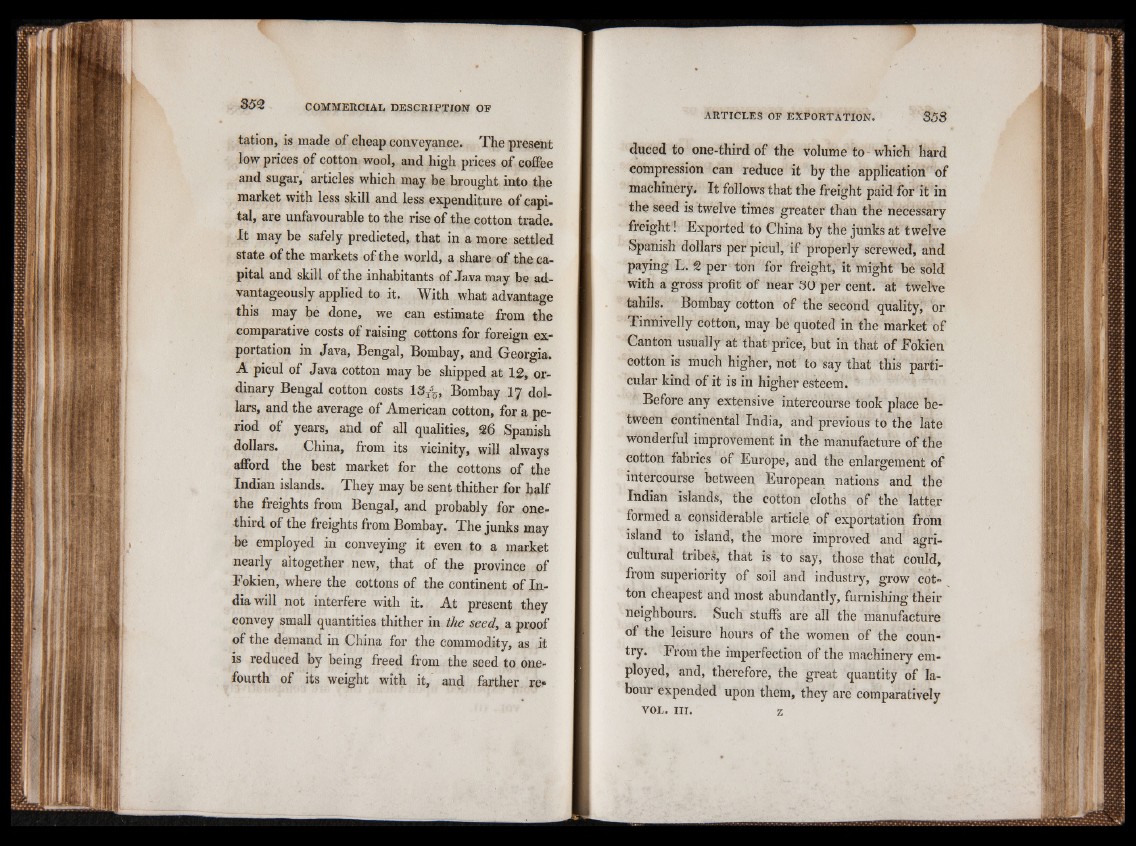
tation, is made of cheap conveyance. The present
low prices of cotton wool, and high prices of coffee
and sugar, articles which may be brought into the
market with less skill and less expenditure of capi-
tal, are unfavourable to the rise of the cotton trade.
It may be safely predicted, that in a more settled
state of the markets of the world, a share of the capital
and skill of the inhabitants of Java may be advantageously
applied to it. With what advantage
this may be done, we can estimate from the
comparative costs of raising cottons for foreign exportation
in Java, Bengal, Bombay, and Georgia.
A picul of Java cotton may be shipped at 12, ar-
dinary Bengal cotton costs 13/ïï, Bombay 17 dollars,
and the average of American cotton, for a period
of years, and of all qualities, 26 Spanish
dollars. China, from its vicinity, will always
afford the best market for the cottons of the
Indian islands. They may be sent thither for half
the freights from Bengal, and probably for one-
third of the freights from Bombay. The junks may
be employed in conveying it even to a market
nearly altogether new, that of the province of
Fokien, where the cottons of the continent of India
will not interfere with it. At present they
convey small quantities thither in the seed, a proof
of the demand in China for the commodity, as it
is reduced by being freed from the seed to one-
fourth of its weight with it, and farther re»
duced to one-third of the volume to- which hard
compression can reduce it by the application of
machinery. It follows that the freight paid for it in
the seed is twelve times greater than the necessary
freight! Exported to China by the juñks at twelve
Spanish dollars per picul, if properly screwed, and
paying L. 2 per ton for freight, it might bé sold
with a gross profit of near 30 per cent, at twelve
tahils. Bombay cotton of the second quality, or
Tinnivelly cotton, may bé quoted in the market of
Canton usually at that price, but in that of Fokien
cotton is much higher, not to say that this particular
kind of it is in higher esteem.
Before any extensive intercourse took place between
continental India, and previous to the late
wmnderful improvement in the manufacture of the
cotton fabrics of Europe, and the enlargement of
intercourse between European nations and the
Indian islands, the cotton cloths of the latter
formed a considerable article, of exportation from
island to island, the more improved and agricultural
tribes, that is to say, those that could,
from superiority of soil and industry, grow cotton
cheapest and most abundantly, furnishing their
neighbours. Such stuffs are all the manufacture
of the leisure hours of the women of the country.
From the imperfection of the machinery employed,
and, therefore, the great quantity of labour
expended upon them, they are comparatively
VOL. III. z